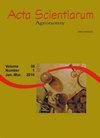Productivity and grain size of coffee grown in different weed management systems
IF 1.2
4区 农林科学
Q3 AGRONOMY
引用次数: 3
Abstract
Intensive weed management is one of the most common practices in coffee cultivation areas. Consequently, some problems, such as soil degradation and the selection of herbicide resistant weed, have increased over time, but, if properly managed, weeds at coffee planting inter-rows can offer benefits of erosion control, nutrient recycling and crop sustainability. The aim of this study is to evaluate the effect of different weed management strategies on the productivity and coffee grain size, i.e., quality. The experiment is installed onto a resprouting Coffea arabica L. site, four years after it was established. Treatments are implanted at planting inter-row Urochloa ruziziensis, Pueraria phaseoloides, and spontaneous vegetation maintained by mowing, herbicides, and weeding. To measure dry matter accumulation, samples are taken with a 0.25 m2 square template at plots maintained by mowing and herbicide application. To evaluate the yield and granulometry, coffee fruits are harvested, processed and classified in a set of 14 sieves (grouped in flat or “moca” shapes). The methods of controlling herbicide and weeding show significance in relation to grain production, with the production of grains having a higher market value standing out, when compared with the other treatments. The accumulation of dry matter above soil, in treatments with herbicides and spontaneous vegetation positively influenced the early coffee productivity (2018), and with U. ruziziensis and spontaneous vegetation, positively influenced the productivity of late harvest (2019). The accumulation of dry matter on the soil tends to be positively linked to coffee productivity, especially in periods when there is a shortage of rain in the region under study; however, it cannot be stated that this influence relationship (causality) has a direct positive effect between dry matter mass production and productivity of future coffee plantations.不同杂草管理系统下咖啡的产量和颗粒大小
集约化杂草管理是咖啡种植区最常见的做法之一。因此,一些问题,如土壤退化和抗除草剂杂草的选择,随着时间的推移而增加,但是,如果管理得当,咖啡种植行间的杂草可以提供侵蚀控制,养分循环和作物可持续性的好处。本研究的目的是评价不同杂草管理策略对咖啡产量和咖啡颗粒大小(即品质)的影响。这个实验是在一个重新发芽的阿拉比卡咖啡基地上进行的,这是在它建立四年之后。在种植行间的ruziziensis、葛根和通过割草、除草剂和除草维持的自然植被中植入处理。为了测量干物质积累,在割草和除草剂维持的地块上用0.25 m2的正方形模板采集样品。为了评估产量和粒度,咖啡果实被收获、加工并分类在一组14个筛子中(按扁平或“moca”形状分组)。除草剂和除草对粮食生产的影响显著,与其他处理相比,粮食生产具有较高的市场价值。在除草剂和自然植被处理下,土壤上干物质的积累对早期咖啡产量(2018年)有积极影响,而在鲁齐齐乌和自然植被处理下,对晚收生产力有积极影响(2019年)。土壤中干物质的积累往往与咖啡产量呈正相关,特别是在研究区域缺少雨水的时期;然而,不能说这种影响关系(因果关系)在干物质产量和未来咖啡种植园的生产力之间有直接的积极作用。
本文章由计算机程序翻译,如有差异,请以英文原文为准。
求助全文
约1分钟内获得全文
求助全文
来源期刊

Acta Scientiarum. Agronomy.
Agricultural and Biological Sciences-Agronomy and Crop Science
CiteScore
2.40
自引率
0.00%
发文量
45
审稿时长
>12 weeks
期刊介绍:
The journal publishes original articles in all areas of Agronomy, including soil sciences, agricultural entomology, soil fertility and manuring, soil physics, physiology of cultivated plants, phytopathology, phyto-health, phytotechny, genesis, morphology and soil classification, management and conservation of soil, integrated management of plant pests, vegetal improvement, agricultural microbiology, agricultural parasitology, production and processing of seeds.
 求助内容:
求助内容: 应助结果提醒方式:
应助结果提醒方式:


